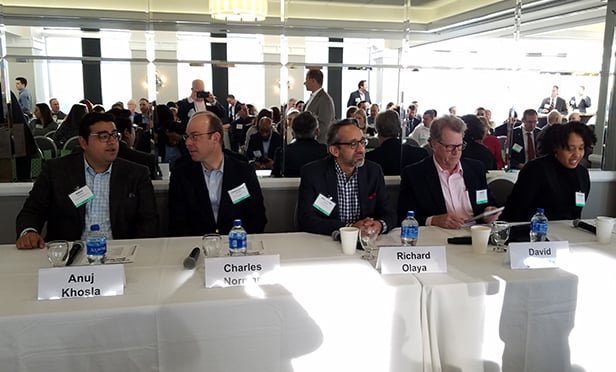 Speakers at the Center City Proprietors Association “Meet the Developers” panel on March 27, 2019 were (from left): Anuj Khosla, managing partner, Khosla Properties; Charles B. Norman, development manager, National Real Estate Development; Richard Olaya, principal, Olaya Design Studio; David Schultz, president, DAS Architects; and Shalimar Thomas, executive director, North Broad Renaissance (Steve Lubetkin photo/State Broadcast News)
Speakers at the Center City Proprietors Association “Meet the Developers” panel on March 27, 2019 were (from left): Anuj Khosla, managing partner, Khosla Properties; Charles B. Norman, development manager, National Real Estate Development; Richard Olaya, principal, Olaya Design Studio; David Schultz, president, DAS Architects; and Shalimar Thomas, executive director, North Broad Renaissance (Steve Lubetkin photo/State Broadcast News)
PHILADELPHIA, PA—Signature development projects that help energize and transform neighborhoods, along with the repurposing of older buildings, and creating new ways for residents to interact with multifamily housing, are among the emerging trends expected to influence commercial real estate in Philadelphia over the next several years, according to a panel of developers who spoke in Center City yesterday.
The “Meet the Developers” panel at the Pyramid Club (atop 1735 Market Street, whose sale to a joint venture led by Silverstein Properties was announced yesterday) is a quarterly fixture of the Center City Proprietors Association, a trade group for retailers and other business owners in Philadelphia.
You can listen to a complete audio podcast of the panel discussion in the player below. If you don't see a player, click here to listen to the podcast.
Community and religious institutions can help anchor a community's revival, says Richard Olaya, principal of Olaya Design Studio.
“One of the things that we just finished is a mosque up in North Philly on North Broad Street, right on Glenwood Avenue behind the Joe Frazier gym,” says Olaya, referring to the newly built Bait-ul-Aafiyat Mosque, 1215 W Glenwood Ave., that his firm designed for the Ahmaddiya Muslim community. “Buildings like that create opportunities that become catalysts for real estate development for housing, just like a church just like a synagogue. Members of that community are going to want to live near that place of worship, and so I think that that's going to become a great opportunity for redevelopment, for revitalization of that area.”
 Bait-ul-Aafiyat Mosque, 1215 W Glenwood Ave., , Philadelphia, PA (Steve Lubetkin Photo/State Broadcast News)
Bait-ul-Aafiyat Mosque, 1215 W Glenwood Ave., , Philadelphia, PA (Steve Lubetkin Photo/State Broadcast News)Hotel projects also tend to generate new commercial activity, says David Schultz, president of DAS Architects.
“We have four hotels underway that are bringing people to Philadelphia, creating lots of jobs,” he says. “In addition to creating jobs, they will also be attractions to people to come to Philadelphia.”
Charles B. Norman, development manager with National Real Estate Development, which is completing East Market, a major mixed retail, office, and multifamily redevelopment between Chestnut and Market Streets, says a key to successful development is to understand a neighborhood's underlying attributes.
“I don't think it's about taking out an eraser and removing what's there,” he says. “Our particular site is like that hole in the doughnut. We had a convention center to the north of us, we had a really vibrant and resurgent Midtown Village neighborhood just to the south of us. We're going to redevelop this block and our sincere hope is that in five to 10 years no one really understands that this block wasn't like this 20 years ago. It becomes part of the fabric.”
Strong retail corridors can be critical to successful redevelopment efforts, says Anuj Khosla, managing partner, Khosla Properties.
“In Brewerytown, they upzoned Girard Avenue, which allows developers to put more density, so allows them to take lower rent on the retail space, and make up for it in the apartments above,” he says. “That allows them to have cooler things like breweries and a gaming lounge, like things that are going to attract tenants.”
The panel sees greater segmentation of living styles in the multifamily market, including senior living, co-living, and empty nesters seeking greater levels of amenities, but also residents who want to age in place, creating greater demand for residential properties that can add things like elevators, accessible bathrooms, and other care packages as residents move into different ages and care needs.
Repurposing existing buildings is also getting increasing attention from developers, says Schultz.
“We've been working on the Curtis Center conversion into luxury residential,” he says. “A lot of great old buildings can be repurposed for new and modern uses, and there's a lot of buildings still available to do that. We have clients coming to us from out of town looking to repurpose buildings, in part because they think it'll be less expensive than doing a new build. So we should focus on our building stock in the core, and make sure we're using it all the best way possible.”
© 2025 ALM Global, LLC, All Rights Reserved. Request academic re-use from www.copyright.com. All other uses, submit a request to [email protected]. For more information visit Asset & Logo Licensing.








